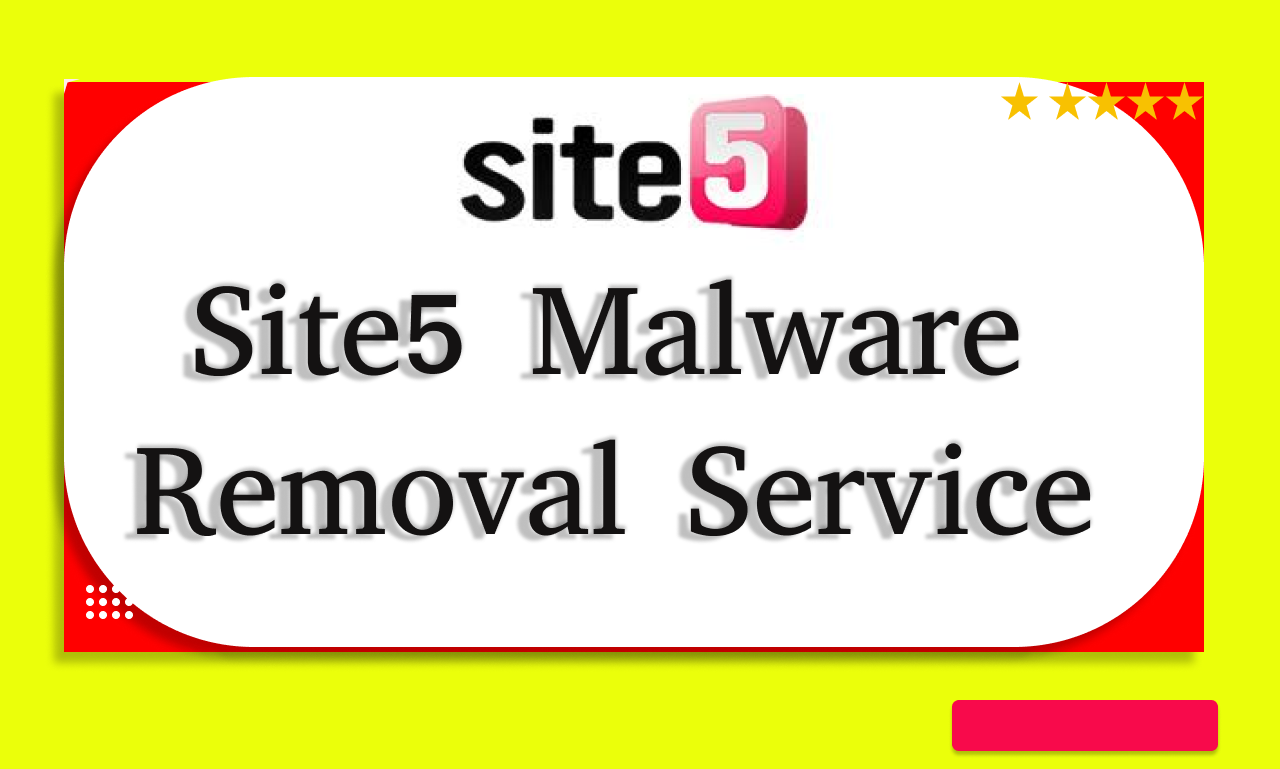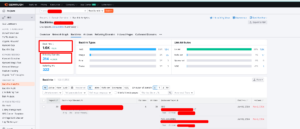Description
Experience peace of mind with WpPiP’s Site5 Malware Removal Service. Our expert team swiftly eliminates malware from your Site5 website, ensuring it remains secure and protected—Trust WpPiP for comprehensive malware removal solutions tailored to your needs.
Site5 Malware Removal: Rescue Your Website from Malware’s Grip!
Is your Site5 website acting strangely? Suspicious pop-ups, sluggish loading times, or even a complete shutdown could indicate a malware infection – a malicious program compromising your website’s security and functionality. But fear not, website owners! WpPiP offers a guaranteed Site5 Malware Removal service to get your website back to its healthy state.
Why Choose WpPiP to Clean Up Your Site5 Website?
-
Swift Action & Secure Results: We understand the urgency of a malware attack. Our team of security professionals will spring into action, minimizing downtime and restoring your website’s functionality with a security-first approach.
-
Site5 Know-How: We are well-versed in the Site5 platform, allowing us to navigate your dashboard effectively for a targeted and efficient removal process.
-
Comprehensive Security Measures: We go beyond simply removing the malware. Our service identifies vulnerabilities used by the malware and implements robust security practices to prevent future attacks, keeping your Site5 website secure in the long run.
-
24/7 Support Network: We are here for you whenever you need us. No matter the time of day or night, our support team is available to address any concerns you may have about your website’s security.
How WpPiP Protects Your Website from Site5 Malware Removal Threats:
-
In-Depth Website Scan: We employ advanced security scanners specifically designed to work with Site5, alongside meticulous manual techniques, to thoroughly examine your website for any trace of malware.
-
Expert Malware Removal and Website Restoration: Once identified, our team carefully removes the malware from your website files, database, and any infected areas, ensuring a complete restoration.
-
Site5 Security Hardening: Following successful removal, we focus on fortifying your website’s defenses. This includes patching vulnerabilities in software and plugins, and configuring security measures within your Site5 dashboard to create a strong security posture.
-
Post-Restoration Monitoring (Optional): In addition to the core service, we offer an optional post-restoration monitoring plan to continuously monitor your website for potential threats and provide regular security reports, giving you long-term peace of mind.
Benefits of Choosing WpPiP’s Site5 Malware Removal Service:
-
Faster Website Recovery: Get your website back online and perform optimally as quickly as possible.
-
Enhanced Security Posture: Our service not only removes existing threats but also strengthens your website’s defenses for long-term protection.
-
Improved User Experience: A malware-free website ensures a smooth, secure, and trustworthy experience for your visitors.
-
Peace of Mind: Knowing your website is secure allows you to focus on running your business or online presence with confidence.
Top 50 types of Site5 website malware that we can remove:
1. Backdoors: Hidden code that grants unauthorized access to a website’s files and systems. 2. Code Injection: Malicious code inserted into legitimate website code, often to steal data or redirect traffic. 3. Cross-Site Scripting (XSS): Exploiting vulnerabilities to inject malicious scripts into webpages, affecting user interaction. 4. Cross-Site Request Forgery (CSRF): Tricking a user’s browser into performing unauthorized actions on a trusted website. 5. Defacement: Malicious modification of a website’s content, often with a message or propaganda. 6. Drive-by Downloads: Malicious code automatically downloads malware onto a visitor’s device when they access the website. 7. Exploit Kits: Pre-built tools that automate attacks by finding and exploiting website vulnerabilities. 8. Fileless Malware: Malware that doesn’t rely on traditional files, making it harder to detect. 9. Formjacking: Stealing user information submitted through website forms, like login credentials or credit card details. 10. Hidden Malware: Malicious code disguised as legitimate content, making it difficult to identify. 11. Injections (SQL, LDAP): Injecting malicious code into databases to manipulate or steal data. 12. Iframe Hijacking: Replacing website content with an iframe displaying malicious content. 13. Malvertising: Malicious advertisements that redirect users to phishing sites or download malware. 14. Mobile Malware: Malware specifically targets mobile devices accessing websites. 15. Phishing: Creating fake login pages or websites to steal user credentials. 16. Ransomware: Blocking access to a website or its data and demanding payment for its release. 17. Remote Access Trojans (RATs): Tools allowing attackers to control infected devices remotely. 18. SEO Spam: Injecting spam keywords to manipulate search engine rankings for the website. 19. Session Hijacking: Stealing a user’s session ID to impersonate them and access their account. 20. Skimming: Stealing credit card information during online transactions. 21. Social Engineering Attacks: Manipulating users into taking actions that compromise website security. 22. Spam Bots: Automated programs that spam message boards or comment sections on a website. 23. Spyware: Software that gathers information about users’ activity without their consent. 24. Steganography: Hiding malware within seemingly harmless files like images or videos. 25. Trojan Horses: Programs that appear legitimate but contain hidden malicious functionalities. 26. URL Redirects: Malicious redirects take users to phishing sites or malware download pages. 27. Watering Hole Attacks: Targeting websites frequented by a specific group of users to infect their devices. 28. Web Bugs: Tiny images embedded in websites to track user activity without their knowledge. 29. Website Backups: Malware that backs up a website’s data for future attacks or data theft. 30. Worms: Self-replicating malware that spreads across websites within a network.
Additional Site5 Malware Types (Focusing on Functionality):
31. Adware: Displays unwanted advertisements on a website. 32. Cryptojacking: Uses website visitors’ processing power to mine cryptocurrency for the attacker. 33. Denial-of-Service (DoS): Overwhelming a website with traffic to make it inaccessible to legitimate users. 34. Link Spam: Inserting irrelevant or misleading links within a website. 35. Malicious Pop-ups: Displaying unwanted pop-up windows with ads, surveys, or fake alerts. 36. Malvertising Redirects: Malicious redirects from legitimate advertising networks. 37. Malicious SEO Redirects: Redirects to spammy or irrelevant content to manipulate search rankings. 38. Password Stealers: Programs that capture user login credentials from forms. 39. Phishing Kits: Pre-built tools for creating and launching phishing attacks. 40. SEO Black Hat Techniques: Unethical methods to improve search engine rankings often harm user experience. 41. Spam Injections: Injecting spam content into forum posts, comments, or contact forms. 42. Spam SEO Backlinks: Creating low-quality backlinks to a website to manipulate search rankings. 43. Spamware: Unsolicited emails promoting products or services, often containing malware links. 44. Spambots: Automated programs that spread spam messages or comments across the web. 45. Spoofing: Impersonating a legitimate website or user to gain trust and steal information. 46. SQL Injection Attacks: Specifically targeting vulnerabilities in SQL databases to steal or manipulate data. 47. Stealer Malware: Malware designed to steal various types of data from websites or user devices, including passwords, financial information, or intellectual property. 48. Traffic Bots: Malicious bots that generate fake website traffic to inflate metrics or manipulate analytics. 49. Watering Hole Attacks (Targeted): Targeting websites frequented by a specific user group with malware relevant to their interests or industry. 50. Zero-Day Exploits: Exploiting vulnerabilities in software before a patch is available, makes them highly dangerous.
Site5 Malware Removal Service Includes:
✅ Hacked website clean Backup files and database
✅Deep malware Scan of all Files and WordPress malware removal
✅Manually remove malware from Full Server or Cpanel
✅Hosting suspension removal
✅Fix redirecting issues
✅Blacklist removal (Google, Norton, McAfee, etc)
✅Google Japanese spam link removal
✅Plugins update
✅Fix website errors
✅SSL Installation
✅Any issue or bug Fixed
✅30 days support
Don’t let a malware infection cripple your Site5 website’s performance and reputation! WpPiP’s Site5 Malware Removal service offers a swift, secure, and effective solution. Our team of experts will remove the malware efficiently, while also fortifying your website’s defenses to prevent future attacks. Contact us today for a free consultation and get your Site5 website back online, healthy, and performing at its best. We are dedicated to partnering with you to ensure the ongoing security of your online presence. Let WpPiP be your shield against malware threats – contact us today!












Reviews
There are no reviews yet.